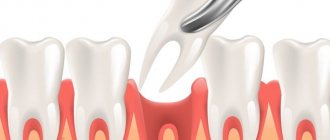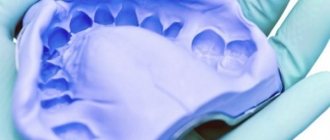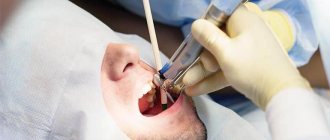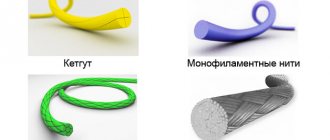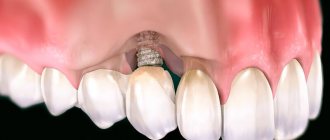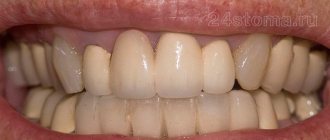The seventh teeth (second molars according to the dental classification) are located in hard-to-reach places. They are often lost due to poor hygiene. Also in this area there are high chewing loads, which accelerates destruction. To restore missing teeth, implants and dentures are used. When removing sevens, a terminal defect often occurs, since wisdom teeth are often removed at the eruption stage or do not erupt at all. In such cases, implantation is the best solution, since it guarantees reliable fixation, restoration of chewing function, and long service life.
Causes and consequences of losing the seventh teeth
Tooth loss usually occurs due to chronic diseases. Sevens are at risk - they are subject to heavy loads when chewing food, and their location does not allow for high-quality hygiene at home. Together, these factors lead to the rapid development of caries, pulpitis and crown destruction. Following the crown, inflammation moves to the root, periodontitis occurs, the formation of granulomas and cysts. If not treated in a timely manner, the inflammatory process spreads over large areas, which leads to the removal of the source of infection. Other reasons:
- periodontitis;
- jaw injuries;
- bone atrophy due to age-related changes;
- congenital anomalies.
The loss of even one unit of dentition leads to the following consequences:
- malocclusion - voids in the dentition lead to a displacement of neighbors towards the missing unit, while the jaws will no longer close as tightly as before;
- diseases of neighboring teeth - when tilted towards the defect, the necks become exposed, sensitivity and inflammation occur;
- diseases of the digestive system - food is not chewed properly, pathologies of the stomach and pancreas develop;
- bone atrophy - due to root loss, the load on the jaw decreases and it becomes thinner;
- change in appearance - tired appearance due to sunken cheeks and wrinkles.
Restorative inlays for restoring chewing teeth
carious destruction occurs , and it is too late for a filling, and too early for a crown, doctors resort to the help of restoration inlays. These are microprostheses that are made from impressions of the patient’s jaws in a separate laboratory, that is, using the indirect method.
Source: zubovv.ru (ceramic inlay)
They are created from photopolymers, pressed ceramics, porcelain or zirconium dioxide - the latter option is the most durable and durable. The finished structure replaces only part of the destroyed crown and, in fact, is a large filling made outside the patient’s oral cavity.
Recovery methods
You can restore sevens by:
- fixation of a dental bridge;
- installation of a removable denture;
- implantation
A bridge in the absence of one tooth consists of three crowns. The outer ones are fixed on the supporting teeth, and the middle one compensates for the lost unit. Since the seventh tooth is usually the end tooth, there is nothing to attach the permanent bridge to. In this case, removable structures are used.
Removable dentures are fixed on the teeth on one side, and glued to the gums with a special gel on the other. This is an inexpensive option, but unreliable - the fixation of the prosthesis is unstable and does not provide functional qualities.
Implants completely imitate the structure of the tooth and are the best solution to the problem. A titanium root is screwed deep into the jaw, and a crown is placed on top. Neighboring units of the dentition are not involved in any way. An artificial tooth is no different from a natural one and takes the same chewing loads.
- Dental bridge
- Removable denture
- Implantation
Removal of a wisdom tooth before implantation of the 6th tooth
The patient went to the Dial-Dent clinic to see dentist S.V. Tsukor. with the desire to carry out prosthetic replacement of one missing tooth in the jaw.
The patient was offered implantation to replace 1 missing tooth. During diagnosis and preparation for dental implantation, the patient was given a panoramic image, which showed the presence of a hidden problem - a wisdom tooth. The treatment plan was changed: first, the patient had to remove the wisdom tooth, then treat the 7th tooth, and only then proceed with dental implantation.
In this case, correct diagnosis (panoramic image of the teeth) helped specialists correctly plan treatment and dental implantation.
Situation at the time of application
Clinical case No. 3
Implantation stages
Implant installation is carried out using the classical method. Includes stages:
Preparatory
Examination and sanitation of the oral cavity, assessment of the condition of bone tissue, examinations, including x-rays and consultation with a therapist. It takes from one to two days (if no contraindications are identified and no sanitation of the oral cavity is required) to a couple of months (if obstacles to the operation are found).
Bone tissue augmentation
Optional step. It is necessary for long-term absence of a tooth, when the jaw at the site of the defect is atrophied and needs to be restored. The material is planted into the alveolar process and waited until it fuses with the bone. The operation itself lasts 2-3 hours, but the recovery period takes up to six months. In cases of minor bone loss, osteoplasty is performed simultaneously with the installation of an artificial root.
Implant installation
The gum is surgically removed and a hole is made in the bone for an artificial root. After installing the implant, a plug is attached on top, and the mucous membrane is sutured. Engraftment up to 6 months.
Installation of the healing abutment
The gums are opened and a former is placed on the titanium root for 10-14 days to create the contours of the gums for the future crown.
Fixation of permanent prosthesis
The former is replaced with an abutment (an adapter between the crown and the implant). The crown is installed using previously taken impressions.
How many canals are there in teeth?
The number of tooth canals does not always coincide with the number of roots. The number of channels can only be determined using x-rays. The upper incisors usually have two or three canals. Some teeth have only one canal, which branches into two parts.
Number of canals in teeth:
- Upper Lower four – 1, less often 2 channels;
- Upper second – 1, less often 2 and even 3 channels;
- Bottom five – one channel;
- Upper first molar 3, 4 canals;
- Lower first molar – 3, less often 2 canals;
- Upper and lower seven – 3, 4 channels.
Is it possible to use express methods for sevens?
Express implantation can be performed in two ways.
Option 1 - place a crown right away
Implantation Immediate Load - instant loading of a titanium root with a crown. In 3-7 days, the patient completes the full course of treatment and receives a new tooth. But this protocol is not suitable for sevens. Usually there is not enough bone tissue in case of loss of the last tooth. And implantation with an immediate load is carried out only when there is a sufficient amount of bone. In case of atrophy, rapid loading does not provide reliable fixation of the titanium root; it cannot be guaranteed that the implants will last the entire period promised by the manufacturer.
Even in the case of ideal conditions with a sufficient amount of bone tissue, it is not recommended to immediately load the seven implant with a crown. The second molar is actively involved in the chewing process; displacement during chewing is possible.
Option 2 - place an implant immediately after tooth extraction
The implant is installed in the hole immediately after the seven is removed. In this case, the healing stage after extraction is skipped, which saves the patient 4-5 months. For 7 teeth, this method is allowed only if there is an adequate amount of bone tissue, planned rather than emergency tooth extraction, the absence of cysts and granulomas on the root, and gentle extraction without damaging the alveolar process.
Teeth numbering system
Dentists have developed a system in which all teeth have their own serial number. The numbering system for the teeth of the lower and upper rows will not allow you to “get confused” in the teeth.
The first number is the incisors - the frontal teeth of the upper and lower rows. There are two teeth on each side (left and right): No. 1 - central, No. 2 - lateral, behind which there are fangs, numbered No. 3. The small molars have numbers 4 and 5.
All of the listed teeth have one cone-shaped root.
Teeth No. 6, 7, 8 - large molars have three roots, and tooth No. 6 of the lower row has one root, with the exception of tooth No. 8, which can have 3 or even 4 roots.
Price
The cost of installing an implant in our Center is standard. Pricing is formed on a turnkey basis. There are several ready-made treatment options. For example, using Nobel Biocare PMC implants, restoring a seven is 20 thousand cheaper than installing a Nobel Biocare Conical Parallel CC. The first ones are used for weak bones, the second ones - of the new generation, for strong ones.
The operation takes place in two stages. At the first, the price includes the procedure itself, the implant and plug, pain relief, consumables, postoperative X-ray examination and CT scan after eight weeks. The application and removal of sutures are also taken into account when determining the cost.
At the second surgical stage, the price list includes painkillers, antiseptics, opening and removal of implant plugs, fixation of gum formers, and consumables.
In the “implantation” case, the cost of surgical treatment does not include crowns. The price depends on the manufacturing method and type of fixation.
Our Center has its own laboratory, where only all-ceramic crowns are manufactured using the Zirkonzahn Schule method. You can order production at the Swiss PROCERA plant, but you will have to wait longer.
The cost of the case does not include sanitation, sinus lift, osteoplasty and temporary prostheses until the implants are healed.
Number of roots in human teeth
There can only be one dental crown, but the number of roots a tooth has depends on its location and purpose. The number of roots is also influenced by hereditary factors. It is possible to determine how many roots a tooth has only with the help of an x-ray. The inner part of the tooth (root) makes up about 70% of the entire tooth.
Factors influencing the number of roots:
- Location of the tooth.
- The purpose of the tooth, its functionality (chewing or frontal).
- Genetic predisposition.
- Patient's age and race. In the European race, the number of dental roots is very different from the Negroid and Mongoloid races.
Guarantees
The Center for Private Dentistry “Doctor Levin” has a guarantee program. The patient of the clinic will receive a guarantee for:
- implant;
- surgery;
- sinus lifting and osteoplasty;
- prosthetics.
Only Lifetime on Nobel Biocare issues a lifetime warranty on the implant; other companies usually provide 25 years.
The warranty provides a year of free service for implantation and two years for all types of treatment. The contract is valid subject to systematic medical examinations and proper care.
Prosthetics with crowns - on a pin or stump tab
If caries is not treated in time, sooner or later the pathological process will reach the pulp - the neurovascular bundle. The main characteristic symptom in this case will be acute pain. In such a situation, most often it is necessary to completely remove the nerve , clean and fill the canals, although sometimes in the early stages it is possible to relieve inflammation with medication.
If by the time you go to the doctor the tooth is already too badly damaged, then the restoration tab will not hold well. In such a situation, you can choose prosthetics with an artificial crown, and for the restoration of the distal parts, metal prostheses, metal-ceramics, zirconium or ceramic composite are usually chosen. It is important that the material is as durable as possible, even at the expense of aesthetics.
If the walls of the visible part of the tooth are preserved and the root is in satisfactory condition, the prosthetic procedure will be carried out in one of the following ways:
Source: dentalsolutions.ru
- with pin installation : to securely fix a single prosthesis, a pin is first inserted into the root canal. Today, strong, but at the same time quite elastic, fiberglass structures are more often used for this purpose, although a metal anchor pin can also be chosen for molars. The fiberglass product usually does not exceed 2 mm in diameter. In appearance, it is a thin matte rod, which becomes the connecting link between the root and the artificial crown,
- on a stump tab : unlike a restoration tab, this tab partially replaces the root system. This is a stronger and more reliable design, which is used when the coronal part is completely destroyed, but subject to the preservation of the root. The lower end of the product is inserted into the root canal, and the tip remains above the gum and serves as a support for the prosthesis.
Source: anzub.ru
Technique for removing a tooth from the lower jaw
- Using a dental smoother, the circular ligament surrounding the dental neck is peeled off. This stage is necessary to reduce damage to nearby soft tissues.
- Forceps delivery. Beak-shaped forceps are indicated for removing lower teeth.
- Move the forceps towards the root system.
- The tongs are clamped as tightly as possible.
- Loosening of the tooth. This stage, if the tooth is single-rooted, is done using the rotation method. Rotation – rotation along an axis. If the structural unit of the jaw is multi-rooted, then it is loosened using the method of luxation (loosening) - back and forth, left and right.
- Extraction from the hole.
- Inspect the hole for fragments and granulations; if there are any, remove them with a curettage spoon.
- A gauze pad is placed on the injured area.
- The patient is advised to discard the tampon after bleeding has stopped. This usually happens within 30 minutes. It is recommended not to eat for two hours. On this day, avoid too hot foods and physical activity.
Patients often ask the question: why can’t you eat exactly 2 hours? This is due to the action of the anesthetic. Removal of the lower units is always carried out under local anesthesia, as a result of which sensitivity is lost not only in the separate structure of the jaw, the entire half of the jaw bone is anesthetized, and along with it the soft tissues of the tongue and cheek. The anesthetic continues to act for 120 minutes, during which time, if a person begins to chew, he will bite his own tissues along with the food without feeling any pain, which will lead to serious injuries. Physical activity and hot foods and drinks can cause bleeding from the socket.
A planned operation to remove lower teeth is performed:
- When dental tissues are destroyed below the gum level. Such a dental unit cannot be used as a support for orthopedic treatment.
- Impenetrable root canals. In this case, conservative treatment becomes impossible.
- Tooth mobility in all planes.
- If, in the case of a jaw bone fracture, a dental unit is found in the fracture line. In this case, without removing the tooth, it is not possible to correctly compare the fragments.
- Dystopian teeth.
- "Eights" covered with a hood of mucous membrane. With frequent exacerbation of pericoronoritis.
Contraindications
Like any dental procedure, extraction surgery sometimes requires a delay. When is this operation contraindicated?
Local contraindications:
- Inflammatory diseases of the soft tissues of the oral cavity (stomatitis, gingivitis, etc.).
- If the dental unit is in the projection of a malignant tumor.
- Damage to the mucous membrane caused by an allergic response (medicinal stomatitis, cheilitis, etc.).
- Manifestation of specific infections in the oral cavity: tuberculosis, syphilis, actinomycosis.
- Radiation therapy or radiation sickness.
- If there is no permanent tooth germ in the jawbone, then removing the temporary unit should be delayed as long as possible.
General contraindications:
- Diseases of the heart and blood vessels.
- Chronic diseases of internal organs in the acute stage.
- Acute degree of mental disorder.
- Infectious disease: measles, chickenpox, scarlet fever, diphtheria, dysentery, influenza.
- Pathology of the nervous system.
- Blood diseases.
- The beginning of pregnancy and the last trimester of pregnancy.
Indications and contraindications for molar tooth extraction
Reasons for removing a molar tooth may be:
- purulent periostitis;
- abscess;
- phlegmon;
- large tumor in the tooth area;
- purulent periodontal disease;
- the presence of a cyst in the area of the diseased tooth;
- exposed pulp;
- longitudinal tooth fracture;
- critical tooth decay;
- critical tooth curvature;
- disease of the dental bone tissue;
- sinusitis.
The following reasons are contraindications to the removal of molars:
- acute heart diseases;
- acute viral diseases;
- flu;
- angina;
- renal failure;
- pancreatitis;
- hepatitis;
- acute diseases of the nervous system;
- oncological diseases
- initial and final stages of pregnancy;
- stomatitis;
- gingivitis
- general degeneration of the body;
- alcohol poisoning.
